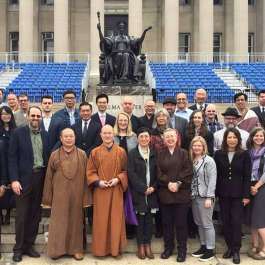
Scriptures state that the Buddhadharma will exist as long as the fourfold sangha exists, meaning bhikshus, bhikshunis, upasakas and upasikas (ordained monks, ordained nuns, laymen, and laywomen). The Buddha ordained the sangha at the beginning of his teaching journey and didn’t pass into parinirvana until the fourfold sangha was firmly established and flourishing.
For the Dharma to flourish, we need the balance of the four parts of the sangha. The Buddha taught monks, nuns, laymen and laywomen alike how to study and practice, yet, after passing to parinirvana, Buddhist teachers focused mostly on monks; their approach wasn’t balanced. This resulted in a weakening of the female monastic community. Consequently, when an extremist Muslim invasion destroyed the monastic community in northern India, laypeople did not know how to study and practice and so became Hindus or Muslims.
Fortunately, the Buddhadharma was preserved in other Asian countries, such as China, Thailand, and Tibet.
Today, we face an imbalance in the fourfold sangha once again. If we focus on Vajrayana Buddhism, we can see that in Western countries and non-Himalayan regions in general, the Dharma is focused mostly on lay practitioners: Dharma centers are led by laypeople to serve the needs of mostly lay practitioners. This is good and benefits many people—except that in this framework, monasticism is often deemed unnecessary. For the first time in the history of Buddhism, much of the ordained sangha is not supported by laypeople, who are encouraged to send money abroad, to support the various projects, monasteries, and activities of the famous, often very well-off head lama. This results in a large majority of lay support being sent overseas—either to Bhutan, Nepal, India, or Tibet, while many practitioners’ own sanghas remain overlooked.

Donors often think that Tibetans are in dire need of support, and in some cases this may be true. But generally speaking, they are one of the best-situated refugees, while at the same time, many the non-Himalayan nuns are alarmingly unsupported. According to several estimations, about 80 per cent of non-Himalayan monastics disrobe in a few years due to lack of different forms of support, from financial to social, spiritual, educational, psychological, medical, and so on.
Of the fourfold sangha required for the survival of the Dharma, nuns are the least supported, in particular non-Himalayan nuns. They are often left with no choice but to disrobe and join the workforce to support their lives, despite their strong desire to live as monastics. Within the fourfold sangha, they are the endangered species that most needs your attention.

Decades ago, when Jetsunma Tenzin Palmo came from the cave and began to advocate for Himalayan nuns, people were surprised: “Oh, nuns! We never hear about the nuns. We know the male teachers and their monasteries, but where are the nuns?”
It took some time and several people to raise awareness, but by the power of her clear vision and the dedicated, diligent work of many people, today Tibetan Buddhist nunneries are thriving and nuns are excelling in education and meditation alike.
What looks impossible becomes possible when we engage in skillful action.

Jetsunma Tenzin Palmo, together with Geshema Kelsang Wangmo and Tsunma Tenzin Sangmo who founded Thosamling nunnery, established the Alliance of Non-Himalayan Nuns (ANHN) to support nuns from non-Himalayan regions. Recognized as a US-based non-profit organization earlier in 2024, the Alliance of Non-Himalayan Nuns, Inc. is governed by its board of directors, which includes representatives from all four major traditions: Kagyu, Gelug, Nyingma, and Sakya. Its supporters include also other luminaries, such as Bhikshuni Karma Lekshe Tsomo, Bhikshuni Thubten Chodron, and Venerable Robina Courtin, to name a few.
In March 2024, 38 nuns from 17 countries and five continents congregated in Thosamling Nunnery in Dharamsala, India, at the first ANHN Gathering to meet, to learn from renowned teachers and each other, to practice together, and to simply enjoy each other’s company, seeing that they are not alone.

Tibetan Buddhist nuns from non-traditional Tibetan Buddhist cultures have a unique set of skills and encounter a unique set of challenges in upholding their vows and robes. These skills are a great advantage if they are noticed. While Himalayan monastics enter monasteries at a young age and have almost no experience of the world outside the monastery, non-Himalayan nuns are often highly educated, accomplished in different careers, such as healthcare, education, finance, the arts, and mental health. They have led companies, acquired soft skills, worked in demanding environments, and have been mothers raising children.
Small children entering a monastery cannot renounce much; often they are just sent there. Meanwhile, these non-Himalayan nuns have often seen worldly success, yet renounced it all to pursue the Dharma and benefit others in a deeper, more far-reaching way. Nonetheless, they remain without the support that the Himalayan monastics receive.
This is shortsighted, since they can significantly benefit Buddhist communities, not only through the sincerity of their practice, but also through the various skillsets they bring from their lives before ordination. This is so often overlooked. They know the world outside the temples and their skills can be utilized for the Dharma to flourish. Many nuns show great resilience and a deep dedication to the Dharma, and continue to serve despite the difficulties they are facing. Without greater support, this is not sustainable.
ANHN was established to support non-Himalayan nuns and at the first gathering discussed above, the nuns have started to organize themselves in mutual support. Even so, we will need a collaborative effort on the part of all four parts of the sangha to tackle the challenges that non-Himalayan nuns face: not being a part of a monastic sangha, staying alone and isolated, and not receiving enough support from the lay community and, sometimes, also from teachers. There needs to be a conscious effort to reframe this situation as a unique opportunity for the Dharma to manifest in non-traditional cultures. It is essential that laypeople are informed about how they can provide greater support.
At the same time, several teachers have expressed their support, among them: His Holiness the Dalai Lama; Mingyur Rinpoche; Khamtrul Rinpoche; Serkong Rinpoche; Geshe Dorji Damdul from Tibet House; and Geshe Ngawang Tenzin, the abbot of Dolma Ling nunnery; together with its leading geshemas. At the recent gathering, there were also heartwarming meetings with fellow nuns from Dolma Ling and Dongyu Gatsal Ling nunneries, and a genuine sisterhood has started to form among the NHNs, inviting more and more nuns to join.
See more
The Alliance of Non-Himalayan Nuns
Related features from BDG
Book Review: The Gathering: A Story of the First Buddhist Women
Buddhistdoor View: Experiencing the Phase Shift – Women in Buddhism Today
Women in Shugendo: Supporters, Leaders, or Both? Part 2
Women in Shugendo: Supporters, Leaders, or Both? Part 1
Women in Buddhism: Breaking Gender Stereotypes
Women in Contemporary Buddhism: A Challenge for the 21st Century
Fearsome and Impeccably Coiffed: Centering Women in Yasodhara
Women of Buddhism
Related news reports from BDG
Fourfold Sangha: Five Nuns from Sravasti Abbey in the US Receive Full Bhikshuni Ordination in Taiwan
International Women’s Meditation Center Foundation Announces Outstanding Buddhist Women for 2024
Sixth Cohort of Tibetan Nuns Awarded Geshema Degrees in Bodh Gaya
Jetsunma Tenzin Palmo among BBC’s 100 Influential Women of 2023
International Women’s Meditation Center Foundation Presents 16 Outstanding Women in Buddhism Awards
Young Buddhist Association of Indonesia Holds Interfaith Dialogue on Women and Spirituality













Many, many thanks for the great article on the nuns and nuns conference.
It is so important that the world knows:
Scriptures state that the Buddhadharma will exist as long as the fourfold sangha exists, meaning bhikshus, bhikshunis, upasakas and upasikas (ordained monks, ordained nuns, laymen, and laywomen). The Buddha ordained the sangha at the beginning of his teaching journey and didn’t pass into parinirvana until the fourfold sangha was firmly established and flourishing.
Many, many thanks anyway for all the great articles you are publishing.
I enjoy them in Switzerland, hopefully I’ll be in Namo Buddha in October for an other 3 months.
Respectfully,
best wishes, for excellent continuation,
may the Dharma continue to spread,
may the great Masters live healthy and long,
may the great Masters who have passed away be soon back and get a good education,
lots of love,
Tenzin Dolma
May the mind of people become peaceful so that the world becomes peaceful